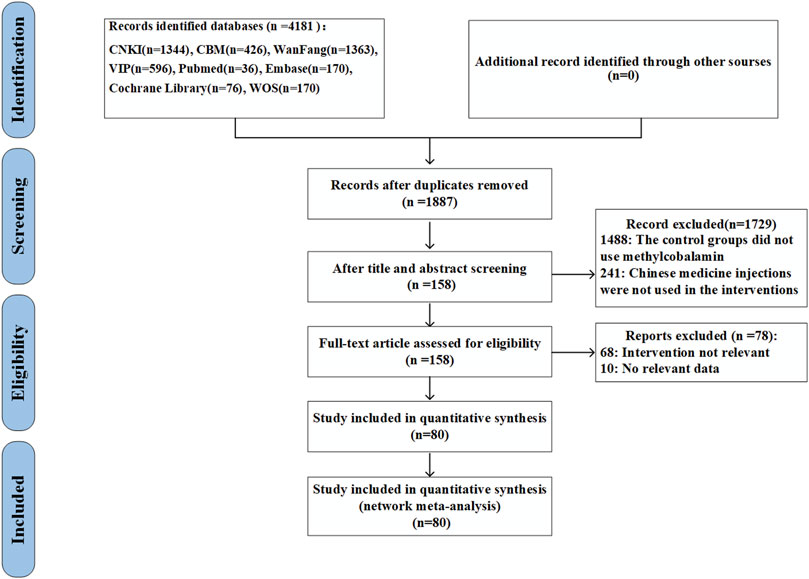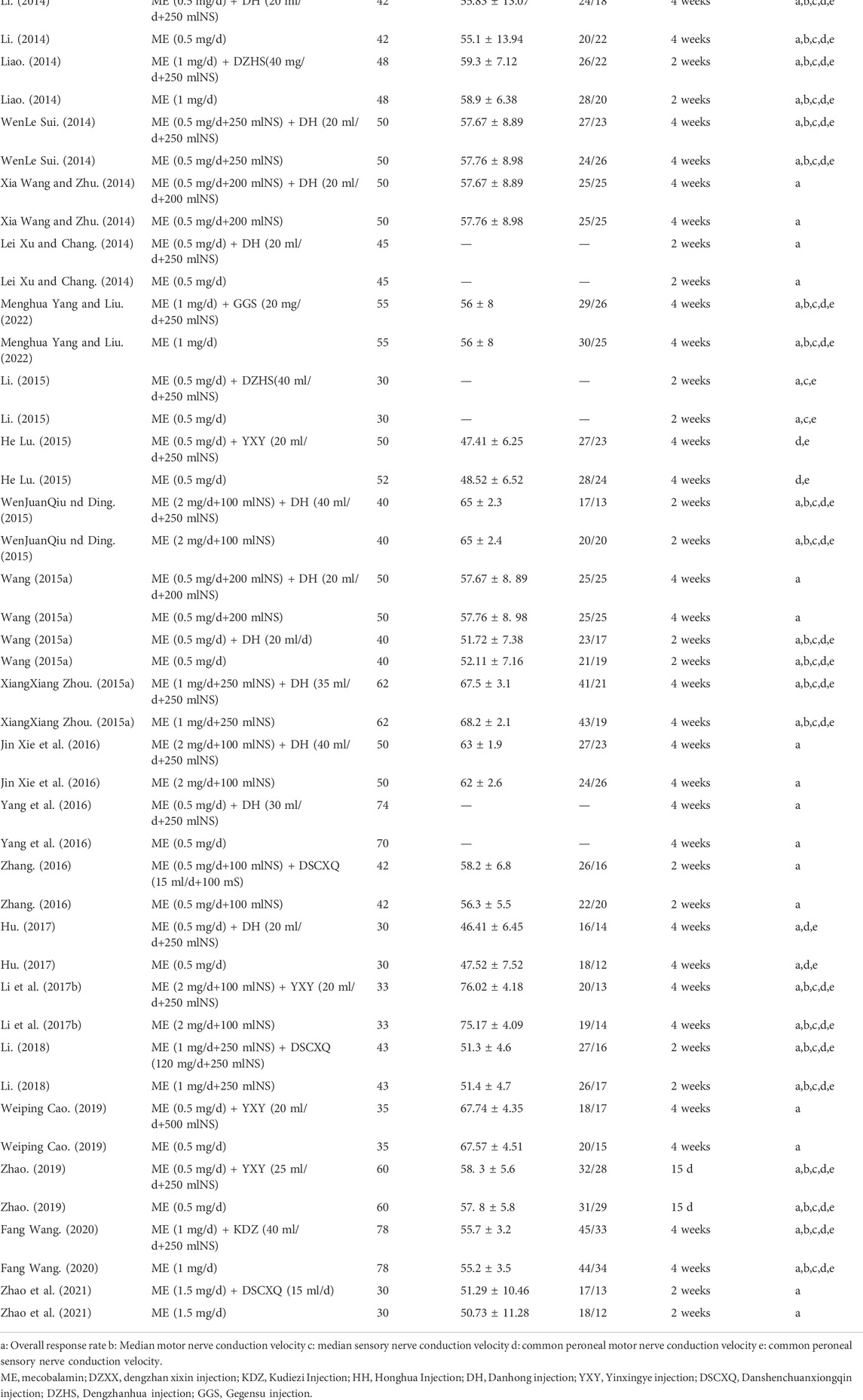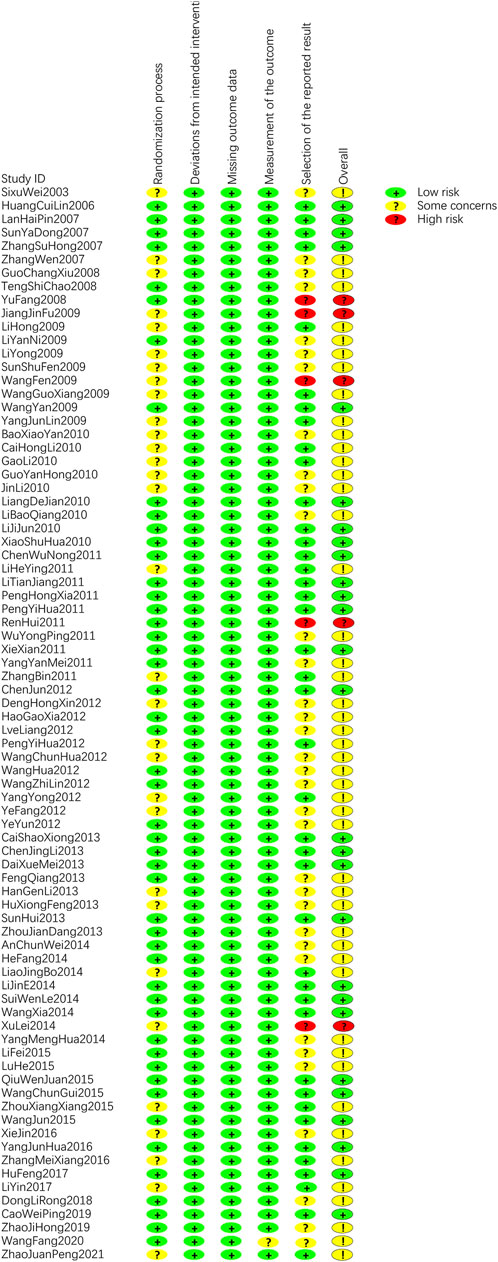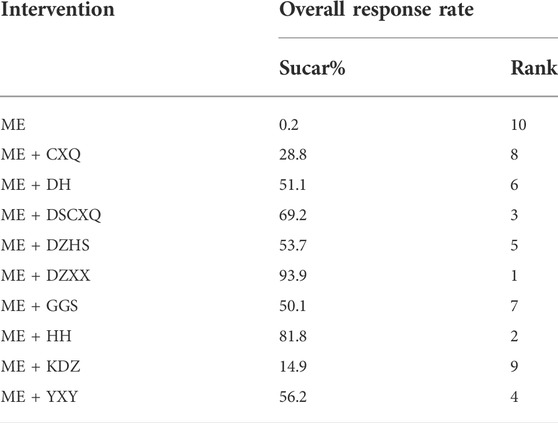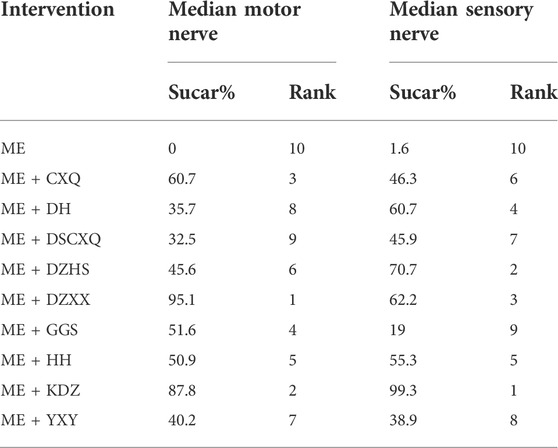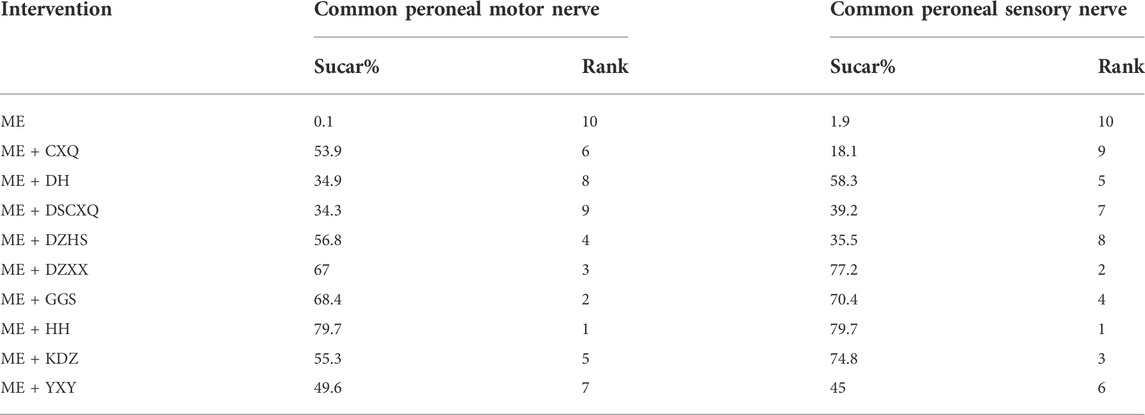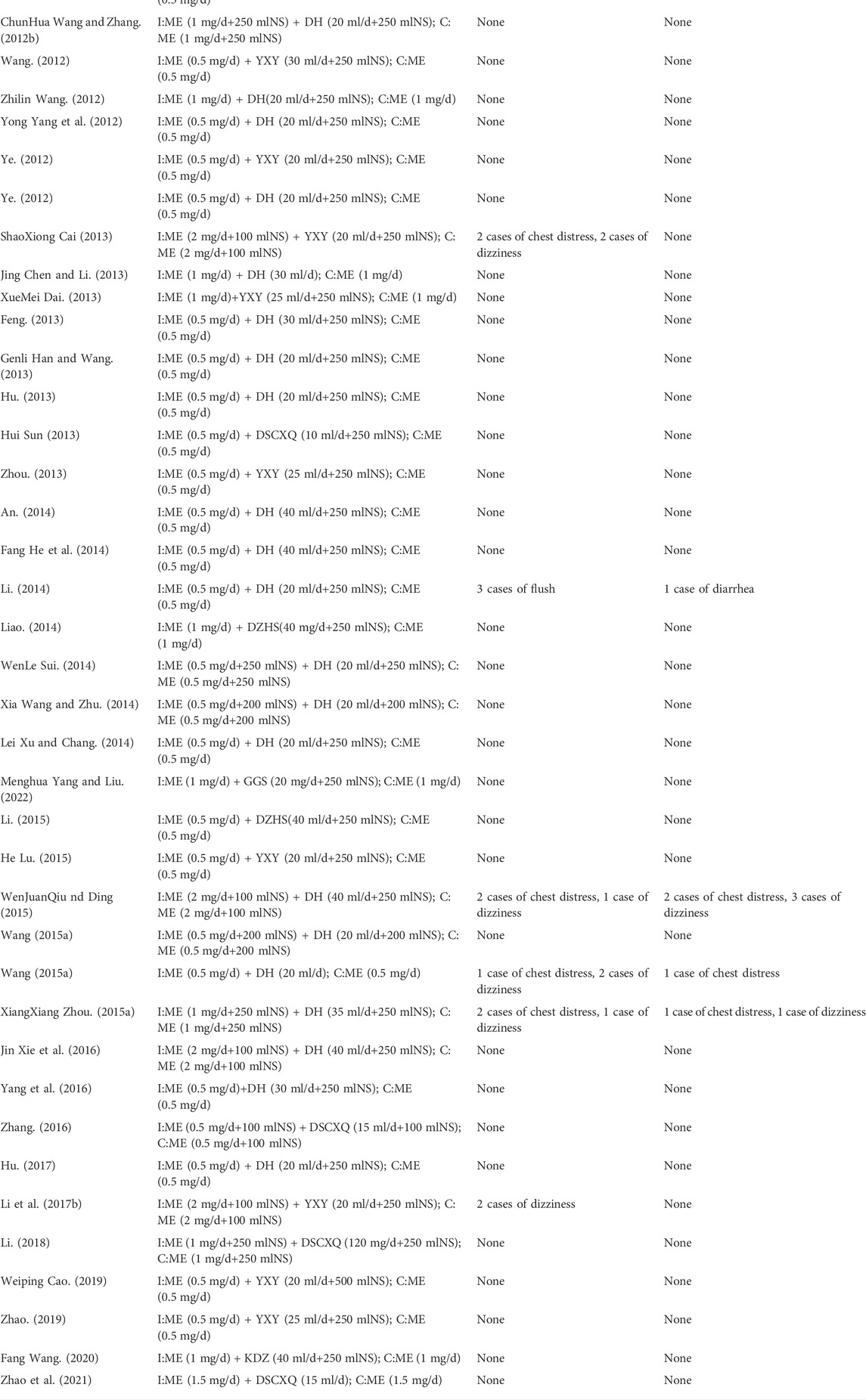- School of Basic Medical Sciences, Chengdu University of Traditional Chinese Medicine, Chengdu, China
Background: In recent years, people pay more and more attention to diabetic peripheral neuropathy (DPN). As a neurotrophic agent, mecobalamin is able to repaire nerves, which has already become a consensus among experts. However, it has been found that mecobalamin has poor effect to increase nerve conduction velocity, which is an important indicator. Clinical data have shown that Chinese medicine injection, combined with mecobalamin injection, can significantly improve nerve conduction velocity of the limbs. Nevertheless, several kinds of Chinese medicine injections have been used to treat DPN. The effect of these Chinese medicine injections for DPN are various. Therefore, it is necessary to evaluate the effectiveness of Chinese medicine injections combined with mecobalamin in the treatment of DPN.
Methods: All relevant articles published before 12 March 2022 were searched in eight electronic databases. Randomized controlled trials (RCTs) on Chinese medicine injections plus Mecobalamin for DPN were identified according to inclusion criteria, and were assessed using the revised Cochrane risk of bias tool (ROB2.0). R software and stata15 was used to create the ranking probabilities and network meta-analysis.
Results: A total of 80 RCTs involving 6,980 patients were included. The results showed that mecobalamin plus Dengzhanxixin injection (ME + DZXX) ranked first in overall response rate [RR = 1.64, 95% CI (1.26, 2.21)] and median motor nerve conduction velocity [MD = 9.46, 95% CI (5.67, 13.28)]. Then, mecobalamin plus Kudiezi Injection (ME + KDZ) had the best effect in median sensory nerve conduction velocity [MD = 10.41, 95% CI (−13.31, −7.52)], and mecobalamin plus Honghua injection (ME + HH) ranked highest in common peroneal motor nerve conduction velocity [MD = 6.8, 95% CI (4.13, 9.49)] and common peroneal sensory nerve conduction velocity [MD = −6.25, 95% CI (−8.85, −3.65)].
Conclusion: This study determined the efficacy of different Chinese medicine injections combined with mecobalamin. DZXX may be the best adjunctive Chinese medicine injection for DPN patients. However, due to potential risk of bias and limited RCTs, our results need to be treated with reservations.
1 Introduction
Diabetic peripheral neuropathy (DPN) is one of the common complications seen in patients with diabetes, and also the main cause of disability and death of diabetes. The clinical symptoms are mainly numbness of the limbs, abnormal sensation, weakening or disappearance of tendon reflexes, etc. In serious cases, gangrene, ulcer, and even amputation may occur (Gong, 2020). With the aging population and unhealthy lifestyle, the number of diabetes patients is increasing more and more. According to current studies, about 10%–50% of people with diabetes may develop DPN, which is a serious medical issue (Aszmann et al., 2004). Currently, the main therapeutic strategies for DPN focus on glycemic control and symptom relief (Hemmingsen et al., 2013).
In 2021, all experts from the diabetes branch of the Chinese Medical Association agreed that mecobalamin injection could alleviate the symptoms related to DPN, and promoted the regeneration of the limbs’ nerves (Neurological Complications Group of Diabetes Branch of Chinese Medical Association LS Zhu and Wu, 2021). However, a study showed that although mecobalamin injection alone could improve the overall treatment efficacy, mecobalamin injection was not effective to increase nerve conduction velocity, which was a crucial indicator (Sawangjit et al., 2020).
Chinese medicine injection has been widely used to relieve DPN in clinical practice recently (Wang, 2022). According to TCM theory, DPN is categorized as “arthralgia syndrome” (Chongze Chen, 2012), Chinese medicine injections can activate blood circulation and remove blood stasis. Various Chinese medicine injections in combination with mecobalamin have been used to alleviate DPN and have increased nerve conduction velocity (Xiao, 2010; Chunhua Wang and Zhang, 2012a; Ye, 2012; Hui Sun, 2013; Shaoxiong Cai et al., 2013; Genli Han and Wang, 2013; Xuemei Dai, 2013; Wenle Sui, 2014; Wang, 2015a; Xiangxiang Zhou, 2015a; Yang et al., 2016; Zhang, 2016; Lirong Dong et al., 2018; Zhao, 2019; Zhao et al., 2021). Several Chinese medicine injections have been developed.
The purpose of this study is to assess the effectiveness of nine Chinese medicine injections combined with mecobalamin in the treatment of DPN.
2 Materials and methods
The protocol has been registered in PROSPERO (CRD42022316703). This study was reported in strict accordance with the standard format and meta-analysis specifications of the Preferred Reporting Items for Systematic Reviews and Meta-Analysis (the PRISMA NMA) (Hutton et al., 2015).
2.1 Literature retrieval
We searched eight databases including China National Knowledge Infrastructure (CNKI), Wanfang Database, Database of Chinese Sci-tech Periodicals (VIP), Chinese Biomedical Literature Database (CBM), PubMed, Cochrane Library, Embase, and Web of Science from inception to 12 March 2022. Both MeSH terms and free words were combined to retrieve relevant RCTs. The search strategies are shown in the Supplementary Material S1.
2.2 Inclusion criteria
2.2.1 Types of studies
We included RCTs, published in English or Chinese, which investigating the effect of Chinese medicine injection combined with mecobalamin for patients with DPN.
2.2.2 Types of participants
The participants were diagnosed according to the “Chinese Guideline for the Prevention and Treatment of Diabetes” (2010 Edition) (CD, 2012); The participants had limb sensory and motor neuropathy manifestations, such as: limb numbness, glove sensation, chills, hyperalgesia or decreased perception of pain and temperature; The participants had evidently weakened or even disappearance of patellar (knee tendon) reflex and ankle jerk (Achilles tendon) reflex during neurological examination; The results of electromyography suggested a slow-down of nerve conduction velocity; The participants aged 40–85 years old, and the treatment period lasted 2–4 weeks, regardless of gender and country.
2.2.3 Interventions and comparison
The intervention group which adopted Chinese medicine injections combined with mecobalamin injection, while the control group used only mecobalamin injection.
2.2.4 Outcome
The primary outcome was overall response rate and secondary outcomes included median motor nerve conduction velocity, median sensory nerve conduction velocity, common peroneal motor nerve conduction velocity, common peroneal sensory nerve conduction velocity, and adverse reactions.
2.3 Exclusion criteria
The exclusion criteria were as follows: 1) duplication; 2) no mecobalamin injection; 3) no relevant data.
2.4 Study selection
EndnoteX9 was used to manage all articles. After removing duplicates, two reviewers (YQM and XGH) scrutinized articles based on the eligible criteria. Then, the full text was read for screening. Disagreements were settled through team discussion or consultation with the third reviewer (YL).
2.5 Data extraction
Two reviewers (YQM and JC) extracted information with pre-designed extraction form. The extracted data included author names, publication dates, interventions (Chinese medicine injections and mecobalamin injections), treatment duration and outcome indicators (primary and secondary outcomes). The extracted data was cross-checked by two reviewers. Discrepancies between the two researchers in the process of study selection were resolved by consensus or negotiation with a third researcher (YL).
2.6 Assessment of risk of bias
The risk of bias of included studies was evaluated using the Cochrane risk of bias tool 2.0 (Rob 2.0) (Sterne et al., 2019). The Rob 2.0 assesses the risk of bias from five domains, including bias generated in the random process, bias deviating from the established intervention, bias of missing outcome data, bias of outcome measurement and bias of selective reporting of results. Two independent reviewers (YQM and JC) conducted evaluation of Rob 2.0 and any discrepancy was arbitrated by a third reviewer (YL).
2.7 Statistical analysis
Stata 15.0, R software and Microsoft Excel 2019 were adopted for statistical analysis. R software (version 4.2.0) was used for data synthesis. The mean difference (MD) and the 95% confidence interval (CI) of continuous variables were measured, and the relative risk (RR) of the 95% CI of dichotomous data was calculated. For dichotomous variables, relative risk (RR) was used as an effect size indicator with a confidence interval of 95% (95% CI) based on the overall response rate of patients (Dias et al., 2013; Mills et al., 2013). For continuous variables such as median motor nerve conduction velocity, median sensory nerve conduction velocity, common peroneal motor nerve conduction velocity and common peroneal sensory nerve conduction velocity, mean difference (MD) with 95% CI was calculated. The Chinese medicine injections were compared using the surface under the ranking plot (SUCRA). The SUCRA curves indicate the most effective and least effective treatments in percentages of 100% and 0%, respectively. SUCRA curves and consistency test were performed using Stata 15 software (Rücker and Schwarzer, 2015; Trinquart et al., 2016). The funnel plot was drawn and compared to determine whether publication bias existed in this network meta-analysis.
3 Results
3.1 Search results
A total of 4181 publications were searched initially, but only 1187 studies left after duplicates were deleted. The titles and abstracts were screened and 158 articles were selected for full-text assessment. Eighty trials were finally included in the present study based on eligible criteria. The detailed literature search process is shown in Figure 1.
3.2 The characteristics of included studies
The present study included a total sample size of 6980 cases, involving 9 interventions: mecobalamin injection + Dengzhan xixin injection (ME + DZXX) (Hong Li and Liang, 2009), mecobalamin injection + Honghua injection (ME + HH) (Huang, 2006; Wen, 2007; Dejian Liang and Zhu, 2010), mecobalamin injection + Danshenchuanxiongqin injection (ME + DSCXQ) (Peng, 2011; Tianjiang Li, 2011; XIan Xie et al., 2011; Hui Sun, 2013; Zhang, 2016; Lirong Dong et al., 2018; Zhao et al., 2021), mecobalamin injection + Yinxingye injection (ME + YXY) (Jiang, 2009; Fen Wang, 2009; Li, 2010a; Bao, 2010; Gao and Zhang, 2010; Xiao, 2010; Wunong Chen and Li, 2011; Yang, 2011; Chen, 2012; Fangye and Liu, 2012; Wang, 2012; Shaoxiong Cai et al., 2013; Xuemei Dai, 2013; Zhou, 2013; He Lu, 2015; Ying Li, 2017; Weiping Cao, 2019; Zhao, 2019), mecobalamin injection + Dengzhanhua injection (ME + DZHS) (Haiping Lan, 2007; Li, 2010b; Peng et al., 2012; Liao, 2014; Li, 2015), mecobalamin injection + Danhong injection (ME + DH) (Guo, 2008; Li, 2009; Shufen Sun, 2009; Wang et al., 2009; Yang, 2009; Yong Li, 2009; Li, 2010b; Guo, 2010; Hongli Cai et al., 2010; Ren, 2011; Wu, 2011; Zhang and Yue, 2011; Chunhua Wang and Zhang, 2012b; Deng, 2012; Liang Lv et al., 2012; Shao, 2012; Ye, 2012; Yong Yang et al., 2012; Zhilin Wang, 2012; Feng, 2013; Genli Han and Wang, 2013; Hu, 2013; Jinli Chen and Li, 2013; An, 2014; Fang He et al., 2014; Lei Xu and Chang, 2014; Li, 2014; Wenle Sui, 2014; Xia Wang and Zhu, 2014; Wang, 2015b; Xiangxiang Zhou, 2015b; Wang, 2015a; Wenjuan Qiu and Ding, 2015; Jin Xie et al., 2016; Yang et al., 2016; Hu, 2017), mecobalamin injection + Gegensu injection (ME + GGS) (Si, 2003; Zhang et al., 2007; Heying Li, 2011; Menghua Yang and Liu, 2022), mecobalamin injection + Chuanxiongqin injection (ME + CXQ) (Sun et al., 2007; Yu, 2008; Wang, 2009) and mecobalamin injection + Kudiezi Injection (ME + KDZ) (Shichao Teng and Wang, 2008; Peng et al., 2011; Fang Wang, 2020). The characteristics of included studies are shown in Table 1. The Supplementary Material S2 presents the specific information of all included Chinese medicine injections. The Chinese medicine injections’ details were showed in the Supplementary Materials S3, 4.
3.3 Risk of bias of the included studies
Although randomization was specified in all 80 articles, 28 articles (Si, 2003; Wen, 2007; Changxiu Guo and Sun, 2008; Hong Li and Liang, 2009; Shufen Sun, 2009; Wang et al., 2009; Yang, 2009; Yong Li, 2009; Bao, 2010; Gao and Zhang, 2010; Guo, 2010; Hongli Cai et al., 2010; Li Jin et al., 2010; Heying Li, 2011; Zhang, 2011; Chunhua Wang and Zhang, 2012b; Deng, 2012; Fangye and Liu, 2012; Peng et al., 2012; Yong Yang et al., 2012; Genli Han and Wang, 2013; Hu, 2013; Liao, 2014; Wang, 2015a; Jin Xie et al., 2016; Zhang, 2016; Ying Li, 2017; Zhao et al., 2021) did not clearly describe the methods of randomization, nor did they mention clear measures of concealment, which were rated as “some concerns”. There were 20 articles (Shichao Teng and Wang, 2008; Li, 2009; Li, 2010a; Wu, 2011; Yang, 2011; Liang Lv et al., 2012; Shao, 2012; Wang, 2012; Ye, 2012; Zhilin Wang, 2012; Feng, 2013; Zhou, 2013; An, 2014; Fang He et al., 2014; He Lu, 2015; Li, 2015; Lirong Dong et al., 2018; Zhao, 2019; Fang Wang, 2020; Menghua Yang and Liu, 2022) with incomplete reports on protocol analysis, which were rated as “some concerns”. There were 5 articles (Yu, 2008; Jiang, 2009; Fen Wang, 2009; Ren, 2011; Lei Xu and Chang, 2014) whose results were selectively reported and rated as “high risk”. In summary, the overall risk of 5 studies was “high risk” (Yu, 2008; Jiang, 2009; Fen Wang, 2009; Ren, 2011; Lei Xu and Chang, 2014), 48 studies was “some concerns”(Lirong Dong et al., 2018), (Genli Han and Wang, 2013), (Ye, 2012; Genli Han and Wang, 2013; Zhang, 2016; Zhao, 2019; Zhao et al., 2021), (Hong Li and Liang, 2009), (Li, 2010a; Bao, 2010; Gao and Zhang, 2010), (Yang, 2011), (Wang, 2012), (Fangye and Liu, 2012), (Zhou, 2013; He Lu, 2015; Ying Li, 2017), (Li, 2010b; Peng et al., 2012; Liao, 2014; Li, 2015), (Li, 2009; Shufen Sun, 2009; Wang et al., 2009; Yang, 2009; Yong Li, 2009; Guo, 2010; Hongli Cai et al., 2010), (Wu, 2011), (Chunhua Wang and Zhang, 2012b; Deng, 2012; Liang Lv et al., 2012; Shao, 2012; Yong Yang et al., 2012; Zhilin Wang, 2012), (Feng, 2013; Hu, 2013; An, 2014; Fang He et al., 2014), (Xiangxiang Zhou, 2015b), (Jin Xie et al., 2016), (Si, 2003), (Heying Li, 2011), (Menghua Yang and Liu, 2022), (Shichao Teng and Wang, 2008), (Wen, 2007; Changxiu Guo and Sun, 2008; Fang Wang, 2020), (Zhang, 2011) and the remaining studies were “low risk” (Huang, 2006; Haiping Lan, 2007; Sun et al., 2007; Zhang et al., 2007; Wang, 2009; Li, 2010b; Dejian Liang and Zhu, 2010; Xiao, 2010; Peng, 2011; Peng et al., 2011; Tianjiang Li, 2011; Wunong Chen and Li, 2011; XIan Xie et al., 2011; Chen, 2012; Hui Sun, 2013; Shaoxiong Cai et al., 2013; Jinli Chen and Li, 2013; Xuemei Dai, 2013; Li, 2014; Wenle Sui, 2014; Xia Wang and Zhu, 2014; Wang, 2015a; Wang, 2015b; Xiangxiang Zhou, 2015b; Wenjuan Qiu and Ding, 2015; Yang et al., 2016; Hu, 2017; Weiping Cao, 2019). The results of risk of bias for included studies are shown in Figure 2.
3.4 Network meta-analysis
We performed a statistical analysis of all indicators using a random-effects model, with a total of 50,000 iterations, starting with the 20001st simulation. The network diagram is shown in Figure 3. The lines in the figure represent the interventions of direct comparison, the line thickness represents the number of studies, and the dot size represents the sample size of the intervention.
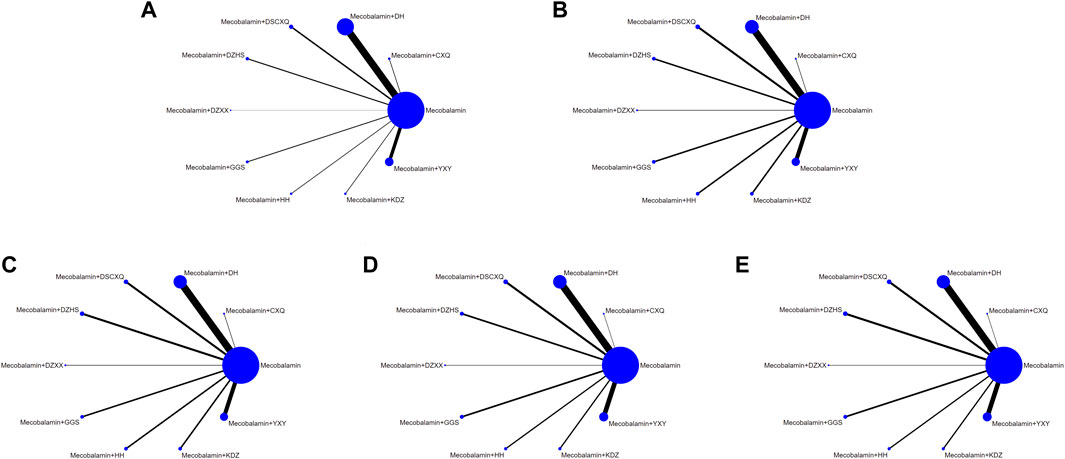
FIGURE 3. Network graphs of outcomes. (A) Overall response rate; (B) median motor nerve conduction velocity; (C) median sensory nerve conduction velocity; (D) common peroneal motor nerve conduction velocity; (E) common peroneal sensory nerve conduction velocity.
3.5 Primary indicators
3.5.1 Overall response rate
A total of 76 studies reported the overall response rate. There were 4 studies on ME + GGS, 3 studies on ME + HH, 5 studies on ME + DZHS, 3 studies on ME + CXQ, 34 studies on ME + DH, 1 studies on ME + DZXX, 16 studies on ME + YXY, 7 studies on ME + DSCXQ, and 3 studies on ME + KDZ. Compared with mecobalamin alone, ME + CXQ [RR = 1.2, 95% CI (1.06,1.36)], ME + DH [RR = 1.29, 95% CI (1.23,1.35)], ME + DSCXQ [RR = 1.34, 95% CI (1.23,1.49)], ME + DZHS [RR = 1.29, 95% CI (1.15,1.46)], ME + DZXX [RR = 1.64, 95% CI (1.26,2.21)], ME + GGS [RR = 1.27, 95% CI (1.13,1.45)], ME + HH [RR = 1.43, 95% CI (1.2,1.74)], ME + KDZ [RR = 1.12. 95% CI (1,1.25)] and ME + YXY [RR = 1.3, 95% CI (1.22,1.39)] had better clinical efficacy (Table2).
As shown in Figure 4 and Table 3, the ranking probabilities results of network-analysis in responder rate were as followed: ME + DZXX (93.9%) > ME + HH (81.8%) > ME + DSCXQ (69.2%) > ME + YXY (56.2%) > ME + DZHS(53.7%) > ME + DH (51.1%) > ME + GGS (50.1%) > ME + CXQ (28.8%) > ME + KDZ (14.9%).
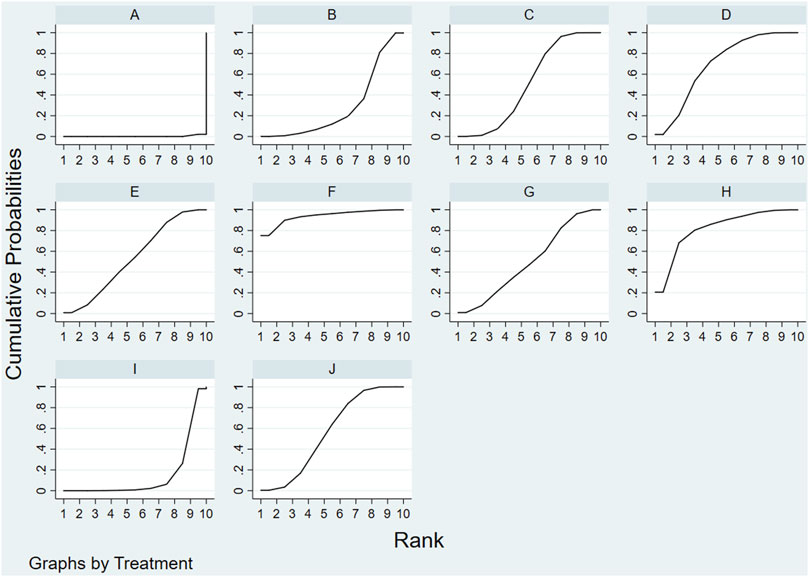
FIGURE 4. Rank of the cumulative probabilities for outcomes: overall response rate. (A): ME; (B) ME + CXQ; (C) ME + DH; (D) ME + DSCXQ; (E) ME + DZHS; (F) ME + DZXX; (G) ME + GGS; (H) ME + HH; (I) ME + KDZ; (J) ME + YXY).
3.6 Secondary indicators
3.6.1 Median nerve conduction velocity
Forty articles reported median motor nerve conduction velocity and 41 articles reported median sensory nerve conduction velocity. As for the median motor nerve conduction velocity, the ranking probabilities results (Table4) of network-analysis showed ME + DZXX (95.1%) > ME + KDZ (87.8%) > ME + CXQ (60.7%) > ME + GGS (51.6%) > ME + HH(50.9%) > ME + DZHS(45.6%) > ME + YXY (40.2%) > ME + DH (35.7%) > ME + DSCXQ (32.5%); with regards to the median sensory nerve conduction velocity, the ranking probabilities results were ME + KDZ (99.3%) > ME + DZHS(70.7%) > ME + DZXX (62.2%) > ME + DH (60.7%) > ME + HH(55.3%) > ME + CXQ (46.3%) > ME + DSCXQ (45.9%) > ME + YXY (38.9%) > ME + GGS (19%) (Figure 5 and Table 5).
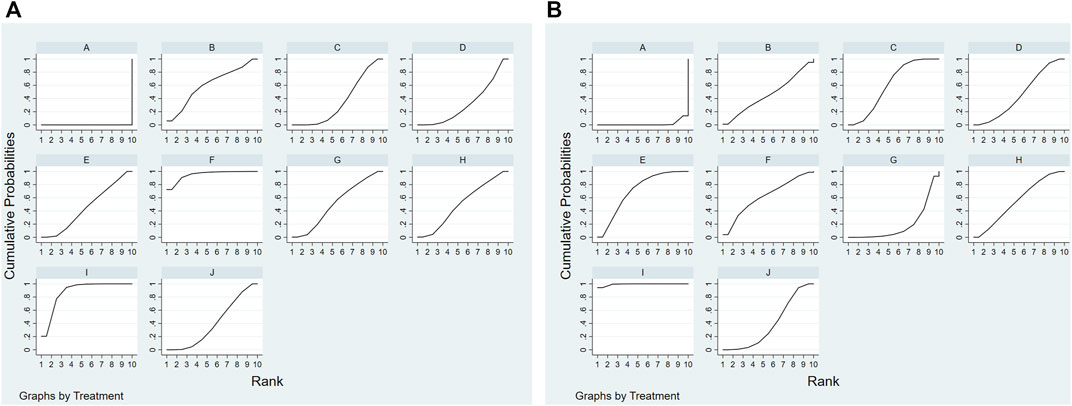
FIGURE 5. Rank of the cumulative probabilities for outcomes: Median nerve. (A) Median motor nerve conduction velocity; (B) median sensory nerve conduction velocity. [(A): ME; (B) ME + CXQ; (C) ME + DH; (D) ME + DSCXQ; (E) ME + DZHS; (F) ME + DZXX; (G) ME + GGS; (H) ME + HH; (I) ME + KDZ; (J) ME + YXY].
3.6.2 Common peroneal nerve conduction velocity
There were 49 articles reporting common peroneal motor nerve conduction velocity and 50 articles reporting common peroneal sensory nerve conduction velocity (Table 6). The rankings results of common peroneal motor nerve conduction velocity were ME + HH(79.7%) > ME + GGS (68.4%) > ME + DZXX (67%) > ME + DZHS(56.8%) > ME + KDZ (55.3%) > ME + CXQ (53.9%) > ME + YXY (49.6%) > ME + DH (34.9%) > ME + DSCXQ (34.3%); meanwhile the rankings results of common peroneal sensory nerve conduction velocity were ME + HH(79.7%) > ME + DZXX (77.2%) > ME + KDZ (74.8%) > ME + GGS (70.4%) > ME + DH (58.3%) > ME + YXY (45%) > ME + DSCXQ (39.2%) > ME + DZHS(35.5%) > ME + CXQ (18.1%) (Figure 6 and Table 7).
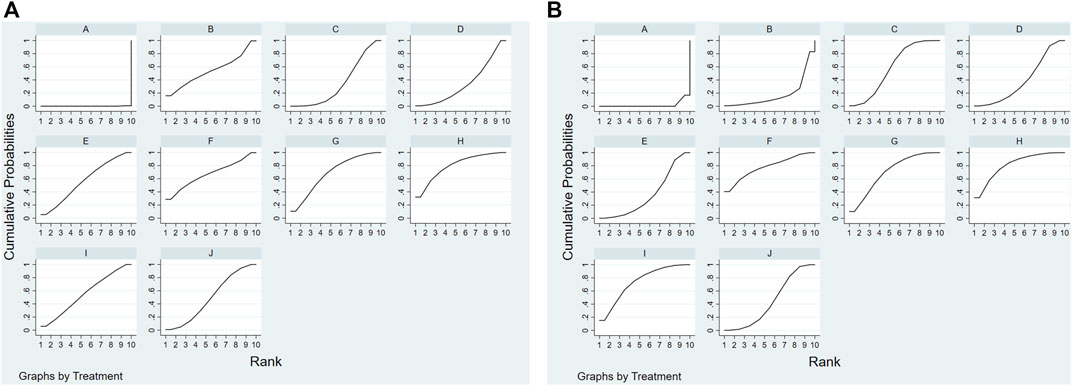
FIGURE 6. Rank of the cumulative probabilities for outcomes: Common peroneal nerve. (A) Common peroneal motor nerve conduction velocity; (B) common peroneal sensory nerve conduction velocity. [(A): ME; (B) ME + CXQ; (C) ME + DH; (D) ME + DSCXQ; (E) ME + DZHS; (F) ME + DZXX; (G) ME + GGS; (H) ME + HH; (I) ME + KDZ; (J) ME + YXY].
3.6.3 Consistency test
Since the network diagram had no closed loop, we performed a consistency test of the included articles. Except CXQ (p = 0.101 > 0.05), GGS (p = 0.16 > 0.05) in Median sensory nerve conduction velocity and CXQ (p = 0.34 > 0.05) in common peroneal sensory nerve conduction velocity, the p values for remaining indicators were all less than 0.05(p < 0.05), indicating significant inconsistency (Supplementary Materials S5–9).
3.6.4 Safety
Adverse reactions were reported in 11 articles involving a total of 30 patients. Adverse reactions of YXY were reported in four articles, with a total of 11 patients (Li, 2010a; Bao, 2010; Shaoxiong Cai et al., 2013; Ying Li, 2017), the adverse events included 1 case of headache, 8 cases of dizziness, 2 cases of chest distress. Six studies reported adverse reactions of DH, with a total of 17 patients (Hongli Cai et al., 2010; Deng, 2012; Li, 2014; Wang, 2015a; Xiangxiang Zhou, 2015b; Wenjuan Qiu and Ding, 2015), the adverse events were 6 case of chest distress,5 case of dizziness, 2 cases of nausea, 1 case of xerostomia, 3 cases of flush. One article reported adverse reactions of HH(33), pruritus in 2 cases. Details of adverse reactions are shown in Table 8.
3.6.5 Publication bias
The funnel plots of overall response rate, median motor nerve conduction velocity, median sensory nerve conduction velocity, common peroneal motor nerve conduction velocity and common peroneal sensory nerve conduction velocity were visually asymmetric, which indicated that publication bias existed in these outcomes (Figure 7).
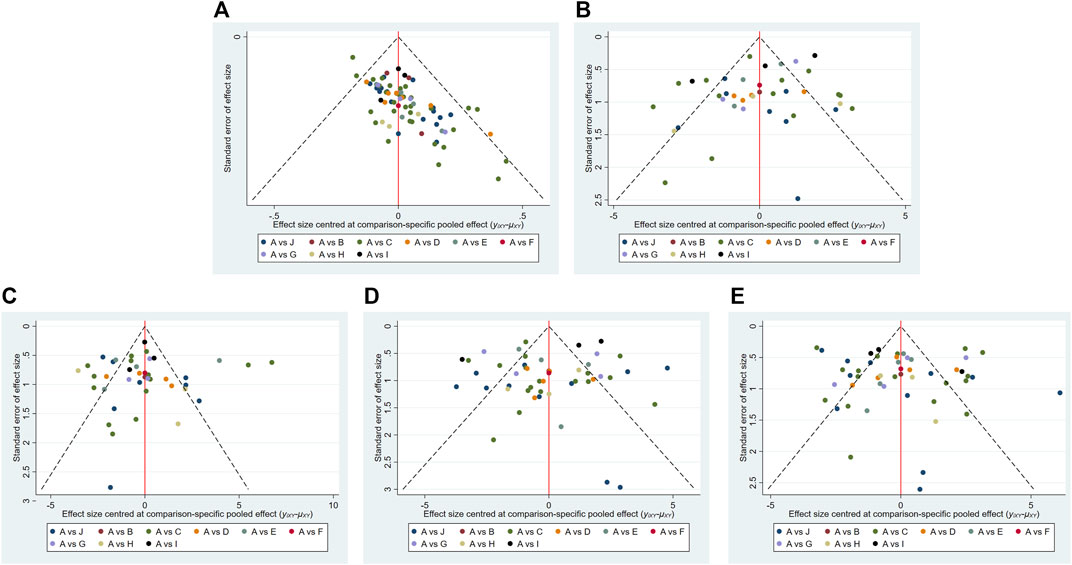
FIGURE 7. Funnel plots of outcomes. (A) Overall response rate; (B) median motor nerve conduction velocity; (C) median sensory nerve conduction velocity; (D) common peroneal motor nerve conduction velocity; (E) common peroneal sensory nerve conduction velocity. [(A): ME; (B) ME + CXQ; (C) ME + DH; (D) ME + DSCXQ; (E) ME + DZHS; (F) ME + DZXX; (G) ME + GGS; (H) ME + HH; (I) ME + KDZ; (J) ME + YXY].
3.7 Sensitivity analysis
Sensitivity analysis was conducted by excluding each trial individually, and the results indicated that the findings were robust.
4 Discussion
The present systematic review and network meta-analysis included 80 studies, the overall risk of bias of 27 were consider as “low risk”, 48 studies were “some concerns” and 5 studies were “high risk”. The results of the network meta-analysis indicated that ME + DZXX was ranking first in improving overall response rate and the median motor nerve conduction velocity. ME + KDZ was ranking first in increasing the conduction velocity of median sensory nerve. ME + HH was ranking first in enhancing the conduction velocity of common peroneal motor nerve and common peroneal sensory nerve.
According to the Results, ME + DZXX was ranking first in terms of overall response rate and median motor nerve conduction velocity. DZXX was approved by the State Drug Administration in 2001. Pharmacological studies indicated that breviscapin in DZXX could reduce platelet damage, improve in vivo activity and exert neuroprotective effect (Li et al., 2017a; Shi et al., 2020). The scutellarin in DZXX have anti-inflammatory effects by blocking the expression of inflammatory genes (e.g., TNF-α, IL-6, NF-κB) (Lin et al., 2019) and inhibiting the TLR4/NF-κB signaling pathway (Zhang et al., 2017). Haiting A et al. found that the effect of DZXX on DPN patients was associated with the protective effect of neuronal mitochondria (An et al., 2021). Meanwhile, Xi J et al. discovered that scutellarin in DZXX could protect vascular endothelial cells from hyperglycemic injury by upregulating mitochondrial autophagy via the PINK1/Parkin signaling pathway (Xi et al., 2021). Among included RCTs, no adverse reactions of DZXX were reported. However, relevant studies suggested that some allergic reactions occured in DZXX (Xin et al., 2011; Li and Xie, 2012), which required to be confirmed in future.
The results revealed that ME + HH was the first in increasing common peroneal motor nerve conduction velocity and common peroneal sensory nerve conduction velocity and ME + KDZ was the first in improving median sensory nerve conduction velocity. Several studies concluded that KDZ and HH could promoted blood circulation and improved the circulatory system (Wang et al., 2018; Yu et al., 2018; Lu et al., 2021). In TCM theory, safflower has the effect of invigorating blood circulation, removing blood stasis and relieving pain, which is also in line with the treatment principle of “arthralgia syndrome” in TCM (Zhang, 2010). Li et al. (2017b) reported safflower extract could reduce neurological damage caused by DPN and its protective effect might be related to the promotion of VEGF-B, NGF, and GDNF expression. Consistent with our study, a meta-analysis revealed that the Kudiezi Injection was beneficial for DPN. However, more high-quality trials were needed to verify its efficacy and safety. (Li, 2018).
5 Limitations
The present systematic review and network meta-analysis had some limitations. First, RCTs of relevant Chinese medicine injections rarely reported adverse reactions, thus it is difficult to confirm the safety of Chinese medicine injections. Second, only one article focused on DZXX and three articles on HH were included. Due to limited RCTs, further clinical trials on DZXX and HH are needed to support our findings. Third, most of included RCTs had some concerns of bias, particularly in the randomization and selection of the reported result. The clinical trials should pay attention to controlling risk of bias.
6 Conclusion
This study determined the efficacy of nine Chinese medicine injections combined with mecobalamin. DZXX may be the best adjunctive Chinese medicine injection for DPN patients. Due to potential risk of bias and limited RCTs, the results need to be treated with cautions.
Data availability statement
The original contributions presented in the study are included in the article/Supplementary Material, further inquiries can be directed to the corresponding author.
Author contributions
YM contributed to conception and design of the study and organized the database. JC performed the statistical analysis. XH wrote the first draft of the manuscript. YM and JC wrote sections of the manuscript. All authors contributed to manuscript revision, read, and approved the submitted version.
Acknowledgments
We would like to thank the researchers and study participants for their contributions.
Conflict of interest
The authors declare that the research was conducted in the absence of any commercial or financial relationships that could be construed as a potential conflict of interest.
The reviewer JL declared a shared parent affiliation with the authors to the handling editor at the time of the review.
Publisher’s note
All claims expressed in this article are solely those of the authors and do not necessarily represent those of their affiliated organizations, or those of the publisher, the editors and the reviewers. Any product that may be evaluated in this article, or claim that may be made by its manufacturer, is not guaranteed or endorsed by the publisher.
Supplementary material
The Supplementary Material for this article can be found online at: https://www.frontiersin.org/articles/10.3389/fphar.2022.957483/full#supplementary-material
References
An, C. (2014). Observation on the curative effect of Danhong injection in the treatment of diabetic peripheral neuropathy. Chin. Foreign Women's Health Mon. 2014 (8), 70.
An, H., Tao, W., Liang, Y., Li, P., Li, M., Zhang, X., et al. (2021). Dengzhanxixin injection ameliorates cognitive impairment through a neuroprotective mechanism based on mitochondrial preservation in patients with acute ischemic stroke. Front. Pharmacol. 12, 712436. doi:10.3389/fphar.2021.712436
Aszmann, O., Tassler, P. L., and Dellon, A. L. (2004). Changing the natural history of diabetic neuropathy: Incidence of ulcer/amputation in the contralateral limb of patients with a unilateral nerve decompression procedure. Ann. Plast. Surg. 53 (6), 517–522. doi:10.1097/01.sap.0000143605.60384.4e
Bao, X. (2010). Ginkgo Damo injection combined with mecobalamin in the treatment of diabetic peripheral neuropathy. Med. Forum Mag. 2010 (13), 2.
Cd, S. (2012). Guidelines for the prevention and treatment of type 2 diabetes in China (2010). Chin. Pract. J. Rural Dr. 2, 5–14.
Changxiu Guo, N. L., and Sun, H. (2008). Observation on the curative effect of integrated traditional Chinese and Western medicine in the treatment of diabetic peripheral neuropathy. Int. J. Traditional Chin. Med. 30 (2), 2.
Chen, J. (2012). Analysis of the clinical efficacy of Ginkgo-Damole combined with mecobalamin in the treatment of diabetic peripheral neuropathy. Front. Med. 1, 1.
Chongze Chen, M. L. (2012). Literature analysis on adverse reactions induced by mecobalamin. Chin. J. Drug Eval. 29 (4), 3.
Chunhua Wang, C. W., and Zhang, Y. (2012). Clinical observation of Danhong injection combined with chemotherapy in the treatment of 30 cases of diabetic peripheral neuropathy. Pract. Clin. Pract. Integr. traditional Chin. West. Med. 12 (3), 2.
Chunhua Wang, C. W., and Zhang, Y. (2012). The efficacy of Danhong injection combined with chemotherapy in the treatment of 30 cases of diabetic peripheral neuropathy. Pract. Chin. West. Med. Clin. 12 (3), 2.
Dejian Liang, J. L., and Zhu, S. (2010). Clinical observation of safflower injection combined with methylcobalamin injection in the treatment of diabetic peripheral neuropathy. Chin. Med. Her. 5 (3), 2.
Deng, H. (2012). Clinical observation of mecobalamin combined with Danhong injection in the treatment of diabetic peripheral neuropathy. Chin. Med. Guide 10 (5), 2.
Dias, S., Welton, N. J., Sutton, A. J., Caldwell, D. M., Lu, G., and Ades, A. E. (2013). Evidence synthesis for decision making 4: Inconsistency in networks of evidence based on randomized controlled trials. Med. Decis. Mak. 33 (5), 641–656. doi:10.1177/0272989X12455847
Fang He, J. L., Wang, M., and Li, B. (2014). Clinical observation of Danhong injection combined with methylcobalamin injection in the treatment of 30 cases of diabetic peripheral neuropathy. Med. Inf. Med. Comput. Appl. 2014 (30), 1.
Fang Wang, Y. L. (2020). Clinical effect of Kudiezi injection combined with methylcobalamin in the treatment of diabetic peripheral neuropathy. Clin. Med. Res. Pract. 5 (23), 3.
Fangye, Y. H., and Liu, C. (2012). Clinical value of Ginkgo biloba injection combined with methylcobalamin in the treatment of diabetic peripheral neuropathy. Fujian Med. J. 34 (4), 3.
Fen Wang, Z. W. (2009). Efficacy observation of Ginkgo biloba injection combined with methylcobalamin in the treatment of diabetic peripheral neuropathy. J. Pract. Med. Technol. 016 (002), 138–139.
Feng, Q. (2013). Efficacy observation of mecobalamin combined with Danhong injection in the treatment of diabetic peripheral neuropathy. Chin. Pract. Med. 2013 (5), 2.
Gao, J. Y., and Zhang, J. (2010). Efficacy observation of Ginkgo biloba injection combined with methylcobalamin in the treatment of diabetic peripheral neuropathy. J. Pract. Chin. Med. 26 (8), 548–549.
Genli Han, Z. Z., and Wang, X. (2013). Efficacy observation of Danhong injection combined with mecobalamin in the treatment of type 2 diabetic peripheral neuropathy. Inn. Mong. Chin. Med. 32 (21), 2.
Gong, Y. W. (2020). Clinical effect of Mudan granule combined with calcium dobesilate on diabetic peripheral neuropathy. China Med. 15 (5), 5.
Guo, C. (2008). Clinical observation on therapeutic effects of treatment of diabetic peripheral neuropathy with integrative traditional Chinese and western medicine. Int. J. Traditional Chin. Med. 30 (2), 1.
Guo, Y. (2010). The clinical observation of treating diabetic perineuropathy by integrated tcm-wm. Chin. J. Med. Guide 12 (6), 1.
Haiping Lan, F. W. (2007). Curative effect observation of Dengzhanhua combined with methylcobalamin in the treatment of diabetic peripheral neuropathy. J. Mod. Integr. Med. 16 (31), 2.
He Lu, X. S. (2015). Observation of curative effect of Ginkgo Damole combined with mecobalamin in the treatment of diabetic peripheral neuropathy. Chin. Med. Guide 000 (034), 378.
Hemmingsen, B., Lund, S. S., Gluud, C., Vaag, A., Almdal, T. P., Hemmingsen, C., et al. (2013). Targeting intensive glycaemic control versus targeting conventional glycaemic control for type 2 diabetes mellitus. Cochrane Database Syst. Rev. 2013 (11), Cd008143. doi:10.1002/14651858.CD008143.pub3
Heying Li, M. W. (2011). Observation of curative effect of puerarin combined with methylcobalamin in the treatment of diabetic peripheral neuropathy. Pract. Clin. Pract. Integr. traditional Chin. West. Med. 11 (5), 2.
Hong Li, Z. L., and Liang, G. (2009). Clinical observation on 64 cases of diabetic peripheral neuropathy treated by Dengzhan Xixin injection combined with mecobalamin injection. Hebei Tradit. Chin. Med. 31 (4), 605–606.
Hongli Cai, M. Y., Shao, L., and Fu, J. (2010). Efficacy observation of mecobalamin combined with Danhong injection in the treatment of elderly diabetic peripheral neuropathy. Chin. J. Pract. Neurological Dis. 13 (3), 2.
Hu, F. (2017). Clinical observation of Danhong injection combined with methylcobalamin in the treatment of 30 cases of diabetic peripheral neuropathy. Dig. latest Med. Inf. world 2017 (81), 2.
Hu, X. (2013). Clinical observation of Danhong injection combined with methylcobalamin in the treatment of patients with type 2 diabetic peripheral neuropathy. Appl. Mod. Med. China 7 (17), 2.
Huang, Y. H. (2006). Clinical observation of safflower injection combined with methylcobalamin in the treatment of diabetic peripheral neuropathy. Clin. Med. China 22 (10), 889–891.
Hui Sun, C. L. (2013). Clinical observation of 57 cases of diabetic peripheral neuropathy treated with Danshen Ligustrazine injection combined with mecobalamin. Chin. Med. Her. 19 (11), 2.
Hutton, B., Salanti, G., Caldwell, D. M., Chaimani, A., Schmid, C. H., Cameron, C., et al. (2015). The PRISMA extension statement for reporting of systematic reviews incorporating network meta-analyses of health care interventions: Checklist and explanations. Ann. Intern. Med. 162 (11), 777–784. doi:10.7326/M14-2385
Jiang, J. F. (2009). Clinical observation for Ginkgo-dipyridamole combined Mecobalamin injection in treating patients with diabetic peripheral nerve diseases. Strait Pharm. J. 1, 1.
Jin Xie, J. G., Xue, Y., Wang, L., and Cao, L. (2016). Application study of methylcobalamin combined with Danhong injection in the treatment of elderly diabetic peripheral neuropathy. Diet. health 3 (020), 34–35.
Jinli Chen, W. S., and Li, L. (2013). Clinical efficacy of Danhong injection in the treatment of 36 cases of diabetic peripheral neuropathy. Contemp. Med. Treatises Second Half Mon. 011 (001), 345–346.
Lei Xu, L. S., and Chang, R. (2014). Efficacy observation of Danhong injection combined with mecobalamin in the treatment of diabetic peripheral neuropathy. J. Henan Med. Coll. 26 (005), 572–573.
Li, B. (2010a). Observation of curative effect of Ginkgo Damole combined with mecobalamin in the treatment of diabetic peripheral neuropathy. Chin. foreign Med. 29 (25), 2.
Li, D., Chen, Y. G., Zhang, C. J., Tian, J., and Li, X. J. C. M. J. (2017). Safflower extract and aceglutamide injection promoting recovery of peripheral innervations via vascular endothelial growth factor-B signaling in diabetic mice. Chin. Med. J. 130, 2829–2835. doi:10.4103/0366-6999.219143
Li, F. (2015). Breviscapine combined with methylcobalamin in the treatment of diabetic peripheral neuropathy. J. Changchun Univ. Traditional Chin. Med. 31 (3), 556–557.
Li, J. (2010b). Effects of therapy of erigeron breviscapus combined with mecobalamin on diabetic peripheral neuropathy. China Pract. Med. 5 (17), 1.
Li, Je (2014). Observation of curative effect of Danhong injection combined with methylcobalamin on diabetic peripheral neuropathy. Gwangmyeong Chin. Med. 2014 (4), 3.
Li, J. G., Wang, L. Q., Yang, X. Y., Chen, Z., Lai, L. Y. W., Xu, H., et al. (2017). Chinese herbal medicine dengzhan xixin injection for acute ischemic stroke: A systematic review and meta-analysis of randomised controlled trials. Complement. Ther. Med. 34, 74–85. doi:10.1016/j.ctim.2017.08.004
Li Jin, H. X., Tian, L., and Che, L. (2010). Clinical study of breviscapine combined with methylcobalamin in the treatment of diabetic peripheral neuropathy. Chin. Pract. Med. 2010 (17), 2.
Li, Y. (2009). Efficacy observation of Danhong injection combined with mecobalamin in the treatment of diabetic peripheral neuropathy. People's Mil. Dr. 52 (1), 2.
Li, Y. S. (2018). Meta-analysis of Kudiezi Injections on the therapies of diabetic peripheral neuropathy. Northwest Pharm. J. 33 (03), 412–417.
Li, Y. Y., and Xie, Y. M. J. C. JoC. M. M. (2012). Literature metrology analysis of adverse reactions reports of Denzhanxixin injection. Zhongguo Zhong Yao Za Zhi 37 (18), 2789–2791.
Liang Lv, X. Z., Meng, S., and Huo, S. (2012). 20 cases of middle-aged and elderly diabetic peripheral neuropathy treated with Danhong injection. Chin. J. Gerontology 32 (24), 2.
Liao, J. O. (2014). Clinical study of methylcobalamin combined with breviscapine in the treatment of 48 patients with diabetic peripheral neuropathy. Yanbian Med. 9 (26), 31–33.
Lin, Y., Ren, N., Li, S., Chen, M., and Pu, P. (2019). Novel anti-obesity effect of scutellarein and potential underlying mechanism of actions. Biomed. Pharmacother. = Biomedecine Pharmacother. 117, 109042. doi:10.1016/j.biopha.2019.109042
Lirong Dong, C. H., Lin, N., and Chen, D. (2018). A clinical analysis and efficacy of ligustrazine injection plus Mecobalamin on diabetic peripheral neuropathy. Clin. J. Chin. Med. 10 (19), 63–65.
Lu, Q., Xu, J., Li, Q., Wu, W., Wu, Y., Xie, J., et al. (2021). Therapeutic efficacy and safety of safflower injection in the treatment of acute coronary syndrome. Evid. Based. Complement. Altern. Med. 2021, 6617772. doi:10.1155/2021/6617772
Menghua Yang, C. Y., and Liu, L. (2022). Efficacy and safety of puerarin combined with mecobalamin in the treatment of diabetic peripheral neuropathy. J. Med. Forum 1, 1.
Mills, E. J., Thorlund, K., and Ioannidis, J. P. (2013). Demystifying trial networks and network meta-analysis. BMJ Clin. Res. ed) 346, f2914. doi:10.1136/bmj.f2914
Peng, H. (2011). Clinical analysis of salvia ligustrazine combined with methylcobalamin in treatment of type 2 diabetic peripheral neuropathy. Chin. J. Postgraduates Med. 34 (31), 1.
Peng, H. Z., Cai, Y., Chen, Y., Yan, Z., Kang, H., and Chen, M. (2012). Clinical analysis of breviscapine combined with methylcobalamin in the treatment of diabetic peripheral neuropathy. J. Clin. Exp. Med. 11 (13), 3.
Peng, Y., Zeng, H., and Cai, Y. J. T. JoM. T. (2011). Clinical effection analysis of ixeris soncifolia hance and methylcobalam on diabetic peripheral neuropathy.
Ren, H. (2011). Efficacy analysis of Danhong injection in the treatment of diabetic peripheral neuropathy. Prim. Med. Forum 15 (25), 2.
Rücker, G., and Schwarzer, G. (2015). Ranking treatments in frequentist network meta-analysis works without resampling methods. BMC Med. Res. Methodol. 15, 58. doi:10.1186/s12874-015-0060-8
Sawangjit, R., Thongphui, S., Chaichompu, W., and Phumart, P. (2020). Efficacy and safety of mecobalamin on peripheral neuropathy: A systematic review and meta-analysis of randomized controlled trials. J. Altern. Complement. Med. 26 (12), 1117–1129. doi:10.1089/acm.2020.0068
Shao, G. (2012). Clinical analysis of Danhong injection combined with methylcobalamin in the treatment of 38 cases of diabetic peripheral neuropathy. J. Clin. Ration. Drug Use 5 (16), 2.
Shaoxiong Cai, Z. H., Zhu, J., Fu, H., Lan, G., and Xiang, H. (2013). Effect of mecobalamin combined with ginkgo dipyridamole injection on senile diabetic peripheral neuropathy. J. Pract. Diabetology 9 (6), 2.
Shi, J., Sun, C., Huang, H., Lin, W., Gao, J., Lin, Y., et al. (2020). β-Glucuronidase- and OATP2B1-mediated drug interaction of scutellarin in dengzhan xixin injection: A formulation aspect. Drug Dev. Res. 81 (5), 609–619. doi:10.1002/ddr.21661
Shichao Teng, X. A., and Wang, X. (2008). Clinical observation of Kudiezi injection combined with methylcobalamin in the treatment of 37 cases of diabetic peripheral neuropathy. Jiangsu Tradit. Chin. Med. 40 (5), 2.
Shufen Sun, M. T. (2009). Observation of curative effect of Danhong injection combined with methylcobalamin in the treatment of DPN. Inn. Mong. Med. J. 2009 (4), 2.
Si, X. (2003). Puerarin combined with methylcobalamin in the treatment of diabetic peripheral neuropathy. Zhejiang Pract. Med. 8 (1), 2.
Sterne, J. A. C., Savović, J., Page, M. J., Elbers, R. G., Blencowe, N. S., Boutron, I., et al. (2019). RoB 2: A revised tool for assessing risk of bias in randomised trials. BMJ Clin. Res. ed) 366, l4898. doi:10.1136/bmj.l4898
Sun, Y. D., Yan, M. A., Lin, Y. L., Han, Y., Guan, H., and Yang, L. J. C. AoT. C. M. (2007). The clinical observe of ligustrazine combining mecobalamine injection to treat diabetic peripheral neuropathy.
Tianjiang Li, G. Z. (2011). Danshen ligustrazine injection combined with mecobalamin in the treatment of diabetic peripheral neuropathy. China Pharm. 14 (7), 2.
Trinquart, L., Attiche, N., Bafeta, A., Porcher, R., and Ravaud, P. (2016). Uncertainty in treatment rankings: Reanalysis of network meta-analyses of randomized trials. Ann. Intern. Med. 164 (10), 666–673. doi:10.7326/M15-2521
Wang, C. (2015a). 50 cases of diabetic peripheral neuropathy treated by danhong injection. China Pharm. 2015 (18), 92–93.
Wang, G., Calderon, J., Jaw, S. J., and Wang, S. Y. (2009). State-dependent block of Na+ channels by articaine via the local anesthetic receptor. J. Membr. Biol. 21 (24), 1–9. doi:10.1007/s00232-009-9170-8
Wang, H. (2012). Clinical effect of ginkgo leaf extract and dipyridamole injection combined with methylcobalamin on diabetic peripheral neuropathy. China Med. Her. 9 (1), 1.
Wang, J. (2015b). Curative effect observation of Danhong needle combined with mecobalamin in the treatment of diabetic peripheral neuropathy. Front. Med. 2015 (3), 2.
Wang, K. H., Li, S. F., Zhao, Y., Li, H. X., and Zhang, L. W. (2018). In vitro anticoagulant activity and active components of safflower injection. Mol. (Basel, Switz. 23 (1), E170. doi:10.3390/molecules23010170
Wang, Y. (2009). Clinical observation of the curative effect of ligustrzing and mecobalamin on diabetic peripheral neuropathy. Med. Innovation China 6 (34), 1.
Wang, Y. Z. (2022). Study on adverse reactions and rational use of traditional Chinese medicine injections. China Med. Pharm. 12 (8), 4.
Weiping Cao, X. C. (2019). Efficacy and safety of Ginkgo-Damole combined with mecobalamin in the treatment of senile diabetic peripheral neuropathy. Contemp. Med. Treatises Second Half Mon. 17 (7), 2.
Wen, Z. (2007). Clinical observation of safflower combined with methylcobalamin in the treatment of diabetic peripheral neuropathy. Chin. J. Compos. Clin. Med. 9 (6), 1.
Wenjuan Qiu, X. Y., and Ding, T. (2015). Efficacy analysis of Danhong injection combined with methylcobalamin in the treatment of senile diabetic peripheral neuropathy. Med. Rev. 21 (23), 3.
Wenle Sui, A. L. (2014). Clinical observation of Danhong injection combined with mecobalamin injection in the treatment of diabetic peripheral neuropathy. New Chin. Med. 046 (008), 132–134.
Wu, Y. (2011). Observation of Danhong injection combined with methylcobalamin in the treatment of diabetic peripheral neuropathy. Strait Pharm. J. 23 (3), 1.
Wunong Chen, G. G., and Li, Z. (2011). Therapeutic observation of 21 cases of diabetic peripheral neuropathy treated with methamphetamine combined with Ginkgo biloba injection. Chin. Prim. Med. 18 (11), 2.
Xi, J., Rong, Y., Zhao, Z., Huang, Y., Wang, P., Luan, H., et al. (2021). Scutellarin ameliorates high glucose-induced vascular endothelial cells injury by activating PINK1/Parkin-mediated mitophagy. J. Ethnopharmacol. 271, 113855. doi:10.1016/j.jep.2021.113855
Xia Wang, R. J., and Zhu, P. (2014). Study on the effect of Danhong injection on diabetic peripheral neuropathy and nerve conduction. Dig. latest Med. Inf. world 14 (29), 2.
Xian Xie, S. L., Wang, X., and Liu, T. (2011). Clinical observation of Danshen Ligustrazine injection combined with mecobalamin in the treatment of diabetic peripheral neuropathy. Chin. J. Clin. Ration. Drug Use 2011 (03), 57–58.
Xiangxiang Zhou, L. W. (2015). Observation on the effect of Danhong injection combined with methylcobalamin in the treatment of senile diabetic peripheral neuropathy. Chin. Rural. Med. 22 (3), 2.
Xiangxiang Zhou, L. W. (2015). The effect of Danhong injection combined with mecobalamin in the treatment of elderly diabetic peripheral neuropathy. China Rural. Med. 22 (3), 2.
Xiao, C. J. (2010). Ginkgo biloba injection combined with mecobalamin in the treatment of diabetic peripheral neuropathy. West China Med. 2010 (6), 3.
Xin, C. W., Ye, Z. W., and Ying, Y. J. C. JoN. D. (2011). Literature analysis of 63 reports of adverse reactions induced by Erigeron breviscapus injection.
Xuemei Dai, D. L. (2013). Observation on the effect of Ginkgo damol combined with mecobalamin in the treatment of type 2 diabetic peripheral neuropathy. J. Difficult Difficult Dis. 12 (3), 2.
Yang, J. (2009). Curative effect observation of Danhong injection combined with methylcobalamin in the treatment of 33 cases of diabetic peripheral neuropathy. Yunnan J. Traditional Chin. Med. 30 (10), 2.
Yang, J., Kim, J. S., Seo, W. Y., and Paik, S. C. (2016). Drinking amount associated with abnormal gamma-glutamyl transpeptidase expression in women. Korean J. Fam. Med. 2016 (19), 2–6. doi:10.4082/kjfm.2016.37.1.2
Yang, Y. (2011). Clinical observation of Ginkgo biloba injection in adjuvant treatment of diabetic peripheral neuropathy. China Tradit. Chin. Med. Inf. 3 (14), 1.
Ye, Y. (2012). Efficacy analysis of mecobalamin combined with Danhong injection in the treatment of 28 cases of elderly diabetic peripheral neuropathy. Med. Inf. 25 (12), 235–236.
Ying Li, Y. X. (2017). Adverse reactions and curative effect observation of Ginkgo Damo injection combined with mecobalamin in the treatment of elderly diabetic peripheral neuropathy. Front. Med. 7 (13), 2.
Yong Li, Z. W. (2009). Observation of curative effect of Danhong injection combined with mecobalamin in the treatment of DPN. J. Pract. Diabetes 2009 (3), 2.
Yong Yang, L. X., Zhu, H., Fan, Y., and Wang, L. (2012). Clinical observation of mecobalamin combined with Danhong injection in the treatment of diabetic peripheral neuropathy. Chin. Med. Guide 10 (26), 2.
Yu, D-D., Xie, Y-M., Zhang, X., Liao, X., Zhi, Y. J., and Zhao, H. (2018). Effectiveness and safety of Kudiezi injection in treating coronary angina pectoris: Systematic review and meta-analysis of randomized controlled trials. Zhongguuo Zhong Yao Za Zhi 43 (20), 4138–4151. doi:10.19540/j.cnki.cjcmm.20180611.014
Yu, F. (2008). Clinical observation of ligustrazine injection combined with methylcobalamin in the treatment of diabetic peripheral neuropathy. Chin. Health Nutr. J. Clin. Med. 17 (8), 2.
Zhang, B. (2011). Efficacy observation of Danhong injection combined with mecobalamin in the treatment of diabetic peripheral neuropathy. Pract. J. Cardiac Cereb. Pneumal Vasc. Dis. 19 (10), 1777.
Zhang, H. (2010). Analysis of the medication rules of traditional Chinese medicine in the treatment of diabetic peripheral neuropathy. Asia Pac. Tradit. Med. 6 (7), 2.
Zhang, L., Sun, S., Li, W., Zhang, W., Wang, X., and Yang, S. Y. (2017). Effect of Scutellarin inhibits collagen-induced arthritis through TLR4/NF-κB-mediated inflammation. Mol. Med. Rep. 16 (4), 5555–5560. doi:10.3892/mmr.2017.7292
Zhang, M. (2016). Clinical observation of Danshen Ligustrazine injection combined with mecobalamin in the treatment of diabetic peripheral neuropathy. J. Pract. Traditional Chin. Med. 32 (10), 1.
Zhang, S., Wang, H., Su, Q., Wang, B. e., Wang, C., Yin, C. h., et al. (2007). [Clinical epidemiology of 1, 087 patients with multiple organ dysfunction syndrome]. Chin. J. Coal Industry Med. 10 (4), 2–6.
Zhang, X. F., and Yue, L. (2011). Efficacy observation of Danhong injection combined with mecobalamin in the treatment of diabetic peripheral neuropathy. J. Pract. Cardiovasc. Cerebrovasc. Dis. 19 (10), 1.
Zhao, J. (2019). Effects of Ginkgo biloba extract combined with methylcobalamin on electromyography in patients with type 2 diabetic peripheral neuropathy. Med. Equip. 32 (10), 2.
Zhao, J., Wang, M., Fan, Y., and Liu, M. (2021). Salviae miltiorrhizae and ligustrazine hydrochloride injection combined with mecobalamin for treating diabetic peripheral neuropathy: A protocol for systematic review and meta-analysis. Medicine 100, e24103. doi:10.1097/MD.0000000000024103
Zhilin Wang, G. W. (2012). Clinical effect of Danhong injection combined with mecobalamin in the treatment of patients with diabetic peripheral neuropathy. Chin. Pract. Med. 7 (21), 2.
Zhou, J. (2013). Therapeutic observation of 80 cases of diabetic peripheral neuropathy treated with methylcobalamin combined with Ginkgo biloba injection. Intern. Med. 2013 (1), 2.
Keywords: Chinese medicine injections, diabetic peripheral neuropathy, network meta-analysis, efficacy, mecobalamin
Citation: Ma Y, Chen J, Huang X and Liu Y (2022) The efficacy and safety of mecobalamin combined with Chinese medicine injections in the treatment of diabetic peripheral neuropathy: A systematic review and Bayesian network meta-analysis of randomized controlled trials. Front. Pharmacol. 13:957483. doi: 10.3389/fphar.2022.957483
Received: 10 June 2022; Accepted: 18 October 2022;
Published: 04 November 2022.
Edited by:
Marcus Tolentino Silva, University of Sorocaba, BrazilReviewed by:
Juan Li, Chengdu University of Traditional Chinese Medicine, ChinaHaolong Liu, Health Science Centre, Peking University, China
Copyright © 2022 Ma, Chen, Huang and Liu. This is an open-access article distributed under the terms of the Creative Commons Attribution License (CC BY). The use, distribution or reproduction in other forums is permitted, provided the original author(s) and the copyright owner(s) are credited and that the original publication in this journal is cited, in accordance with accepted academic practice. No use, distribution or reproduction is permitted which does not comply with these terms.
*Correspondence: Yuan Liu, MTY0MDMwNDcyMUBxcS5jb20=
 Yuqi Ma
Yuqi Ma Yuan Liu
Yuan Liu